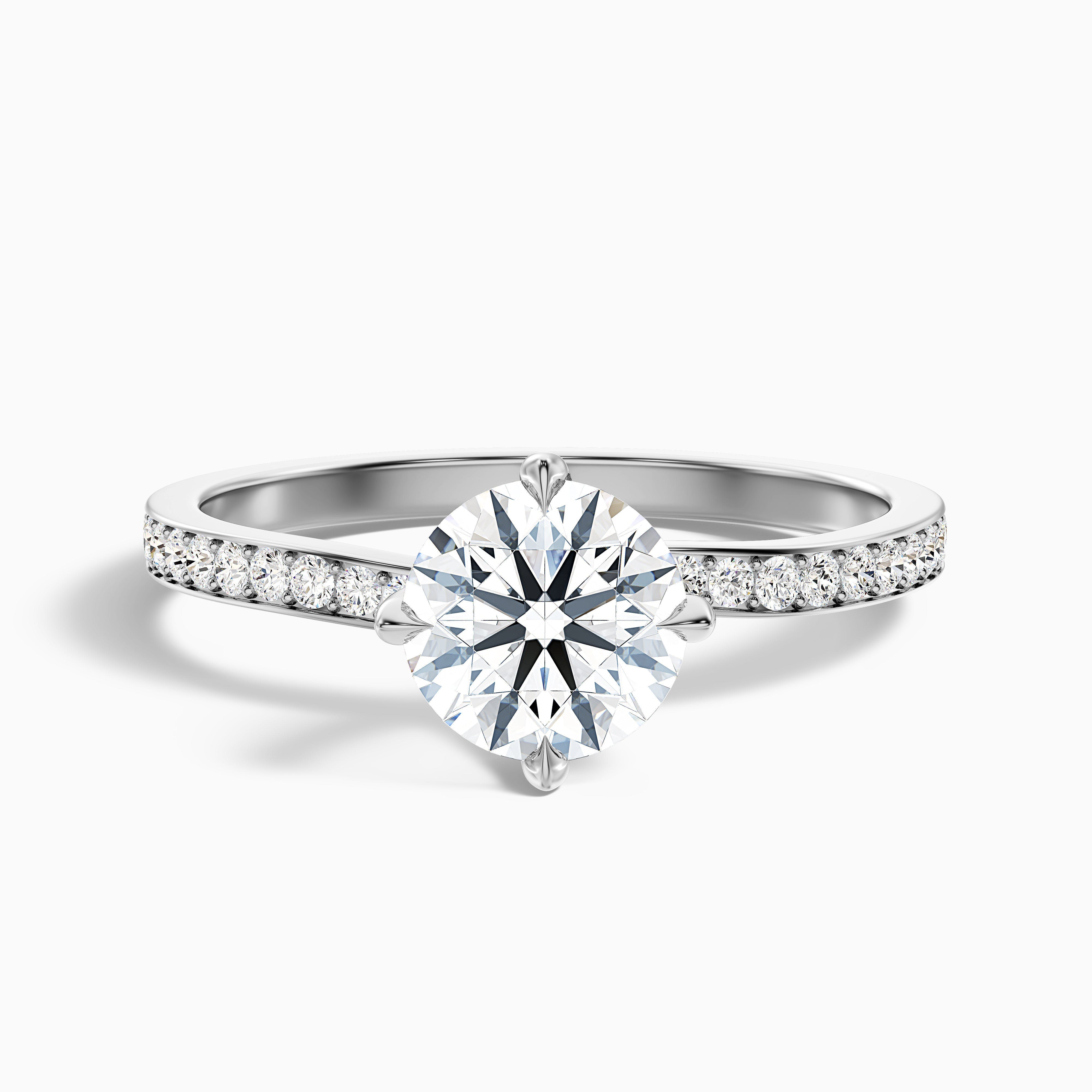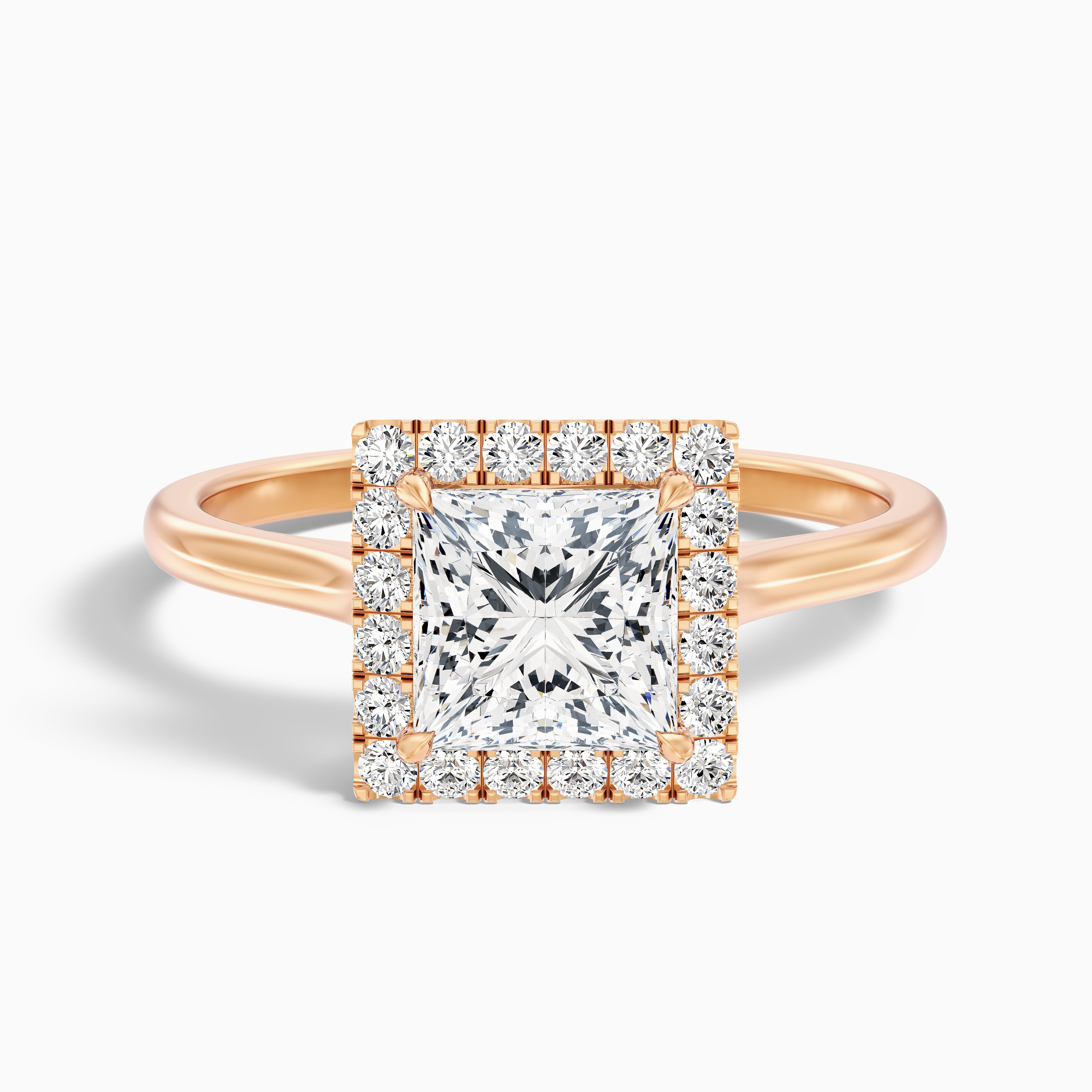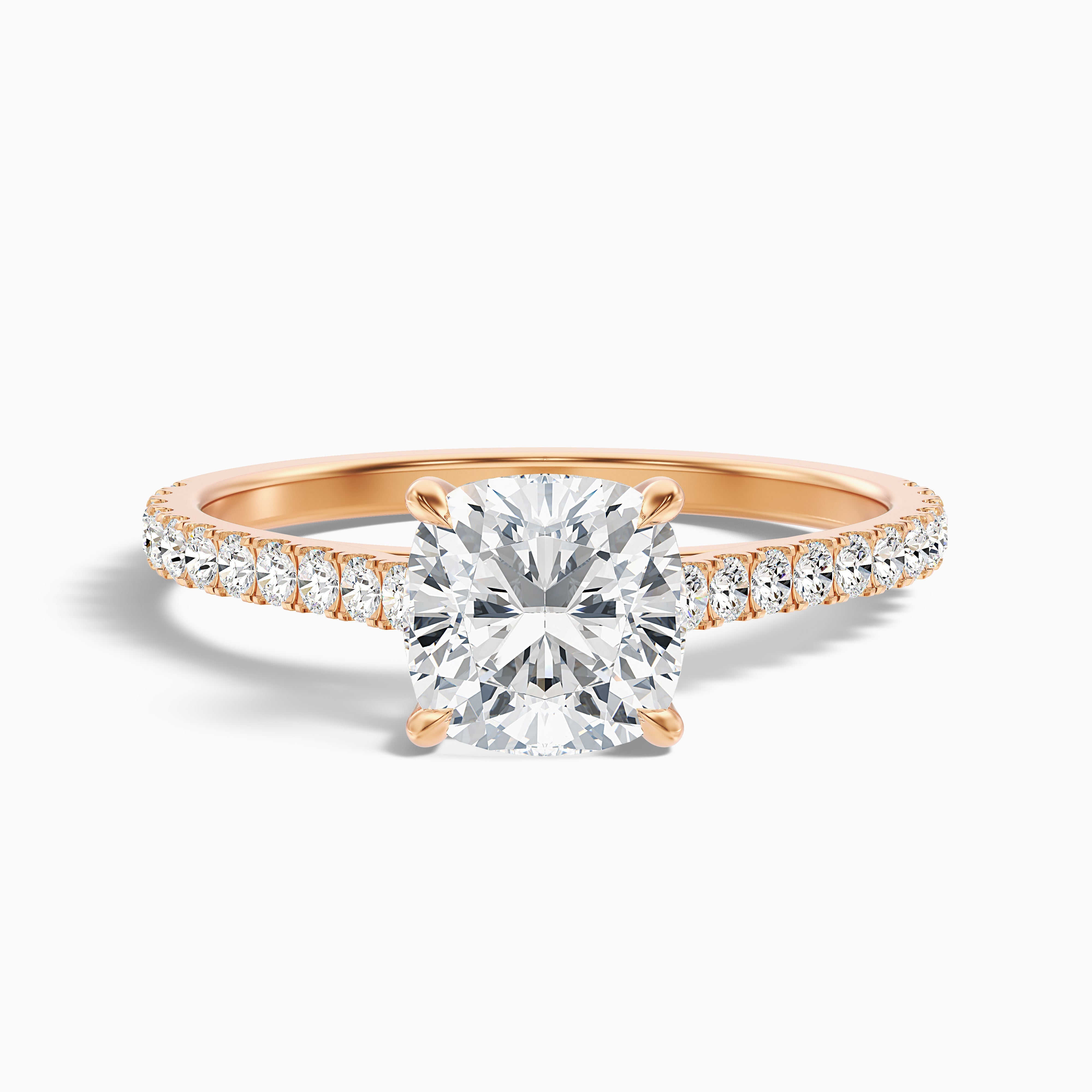Cubic Zirconia Vs Lab Diamond: Key Differences
Remember how Holly Golightly stood before the diamonds in "Breakfast at Tiffany's"? That same charm still draws us in, but shoppers today have more options than in Audrey Hepburn's time. When you compare cubic zirconia vs lab diamonds, you enter an interesting world where science makes beauty at wildly varying prices. These stones look exactly like a diamond, and the other is a diamond—it was born in a lab instead of deep in the earth. Your beautiful sparkle is out there, but how do you get to it? Let us find out.
1. What is Cubic Zirconia?

Have you ever thought about whether the beautiful stone in your friend's new ring is really a diamond? It could be cubic zirconia (CZ), which is the most common man made diamond substitute in the world. CZ has been around since 1976 and is more than just a pretty face in the jewellery box. The material that makes up this man made gem is zirconium dioxide (ZrO2), which was carefully heated to form crystals that look a lot like real diamonds.
In the comparison of lab grown diamonds vs. cubic zirconia, CZ was originally developed for laser applications but quickly found a place in jewellery as a far more affordable diamond alternative, engineered to capture the same brilliant sparkle.
There are now $20 fashion rings and hundreds of dollars wedding sets with cubic zirconia as the main stone. Trend following fans who want size and sparkle without spending a lot of money will love how versatile it is. CZ has made the diamond look more approachable, so almost anyone can get that desired shine.
2. What are Lab Grown Diamonds?

Don't be fooled by misconceptions lab grown diamonds are not cubic zirconia in disguise. These are genuine diamonds with identical chemical composition to mined stones. The key difference? Their birthplace is a laboratory rather than Earth's crust.
Creation Methods
Scientists craft these genuine diamonds using two fascinating techniques:
- HPHT (High Pressure High Temperature) — This method mimics nature's process, subjecting carbon to extreme pressure (approximately 1.5 million pounds per square inch) and temperatures exceeding 2,700°F. The result? Carbon atoms arrange themselves into diamond crystal structures.
- CVD (Chemical Vapour Deposition) — Think of this as diamond "growing" from a gas cloud. A diamond seed is placed in a chamber filled with carbon rich gas, which deposits layer by layer onto the seed, building a diamond atom by atom.
The science might sound complicated, but the outcome is simple: real diamonds created through human ingenuity rather than geological processes. And they're rapidly changing the jewellery landscape as we know it.
3. Physical and Chemical Properties
Let's get down to the nitty gritty of what makes these sparklers tick. Many jewellery shoppers wonder, "are lab grown diamonds the same as cubic zirconia?" The answer lies in their fundamental physical and chemical makeup, and the differences are substantial.
Composition
- Cubic Zirconia: Made of zirconium dioxide (ZrO2), this synthetic material contains zero carbon. CZ often incorporates stabilizing elements like yttrium or calcium to maintain its crystal structure.
- Lab Grown Diamonds: Chemically identical to mined diamonds—pure crystallized carbon (C). When you're holding a lab grown diamond, you're literally holding compressed carbon arranged in a precise crystalline structure.
Hardness
- Cubic Zirconia: Scores 8-8.5 on the Mohs hardness scale. Pretty tough, but not invincible. Your CZ jewellery will eventually show scratches with daily wear.
- Lab Grown Diamonds: Hit the top of the charts at 10 on the Mohs scale—the hardest known natural substance. This explains why your grandmother's diamond ring still looks pristine after decades.
Brilliance and Fire
- Cubic Zirconia: Actually outshines diamonds in terms of fire (colorful light dispersion). That rainbow effect you see? That's CZ showing off its higher dispersion rate of 0.060.
- Lab Grown Diamonds: Exhibits balanced brilliance (white light return) with a dispersion rate of 0.044, creating that characteristic diamond sparkle that's been captivating humans for centuries.
Refractive Index
- Cubic Zirconia: 2.15-2.18, slightly higher than diamond
- Lab Grown Diamonds: 2.42, creating that signature "diamond look"
The science doesn't lie—these are fundamentally different materials despite their similar appearance to untrained eyes.
4. Appearance and Aesthetics
To the untrained eye walking through a shopping mall, both stones catch the light beautifully, but place them side by side, and even amateur gem enthusiasts start noticing key differences.
The Sparkle Factor
Lab diamonds exhibit what jewelers call "brilliance with depth." Light penetrates deep into the stone, bouncing back with that characteristic diamond sparkle a bit like looking into clear water. Cubic zirconia, while certainly flashy, reflects light more on the surface with a slightly more "flat" appearance.
Think of it this way: CZ is like the person at a party who laughs loudly at every joke—lots of flash and immediate appeal. A lab diamond is more subtle but complex, revealing new facets of beauty as you spend time with it.
Color Characteristics
Most CZ comes in flawless colorless form almost suspiciously perfect compared to natural and lab diamonds, which typically contain tiny inclusions or slight color variations.
The Discerning Eye
Here's a trade secret: jewelers often spot CZ by its weight. It's approximately 1.7 times heavier than a diamond of identical size. Pick up a 1 carat diamond and a 1 carat CZ, and you'll feel the difference.
Over time, cubic zirconia tends to develop a cloudy appearance as microscopic scratches accumulate on its surface. Lab diamonds maintain their clarity for decades, just one reason why lab created diamonds vs cubic zirconia represent different classes of investment.
5. Cost Comparison
Let's talk about money, because when comparing lab diamond vs cubic zirconia, the price tag shows the most dramatic difference. This might be the deciding factor for many budget conscious shoppers.
Cubic Zirconia: The Budget Champion
If diamonds are financially out of reach, CZ delivers serious bang for your buck:
- A stunning 1 carat CZ ring? Approximately $14.
- Going big with a 3 carat statement piece? Around $190.
- Custom designer settings with CZ stones? Still typically under $500.
I recently spotted a gorgeous tennis bracelet studded with cubic zirconia for $75 that looked remarkably similar to its $5,000 diamond counterpart. For fashion jewellery that might follow trends rather than become heirlooms, CZ makes perfect financial sense.
Lab Grown Diamonds: The Middle Ground
Lab diamonds occupy that sweet spot between CZ and mined diamonds:
- A well cut 1 carat lab diamond ring? Approximately $3,630.
- That impressive 3 carat statement piece? $25,000+.
- The savings? Lab grown diamonds typically cost 80-90% less than mined diamonds.
"I was dead set on a two carat engagement ring but didn't have $20,000 for a mined diamond," shares Jennifer, a recent bride. "Our lab grown diamond gave us the size and quality we wanted for around $7,000."
Long Term Value Considerations
Here's where things get interesting. Unlike natural diamonds, which can appreciate over time, lab diamonds typically lose 50-70% of their value upon resale. Cubic zirconia? Essentially zero resale value.
But let's be real like how many of us actually resell our jewellery? For most people, the emotional value far outweighs potential investment returns. The question becomes: What value do you place on authenticity versus appearance?
6. Durability and Maintenance
When people ask, "are lab grown diamonds cubic zirconia?" I always emphasize the durability difference. These two stones might look similar on day one, but fast-forward a few years, and their divergent paths become crystal clear.
Cubic Zirconia: The High Maintenance Option
CZ is gorgeous at first, but needs a little TLC to get it sparkling:
- 8-8.5 hardness rating = susceptible to scratching through regular use
- Typically forms observable wear between 1-2 years under heavy usage
- Scratches on the surface create a hazy appearance over time
- More prone to chipping if accidentally dropped on hard surfaces
"I adored my cubic zirconia engagement ring the first year," admits Taylor, a graphic designer. "By year three, it looked decidedly dull, and no cleaning restored that initial sparkle."
Lab Grown Diamonds: Built to Last
Lab diamonds possess the fabled hardness of their natural counterparts:
- Top-of-the-line hardness rating of 10 scratch resistant to nearly everything but another diamond
- Retains optical properties forever
- Chipping and cracking resistant, may be worn daily
- Can be passed down through generations without degradation.
Practical Maintenance Tips
For cubic zirconia:
- Wash monthly with gentle soap and water
- Avoid harsh chemicals and ultrasonic cleaners
- Think of exchanging stones periodically every few years for bigger ones
For lab diamonds:
- Regular diamond cleaning products are perfect
- Annual professional cleaning ensures maximum brilliance.
- No replacement needed ever
The durability factor makes lab grown diamonds an especially good option for engagement rings and other items that are headed for decades of daily wear.
7. Ethical and Environmental Considerations

The jewellery on your finger tells a story not just about your style, but about your values. Today's consumers increasingly consider the ethical footprint of their sparkly purchases.
Cubic Zirconia: The Synthetic Solution
CZ presents a straightforward ethical profile:
- Zero connection to mining conflicts or labor concerns
- Laboratory creation eliminates habitat destruction
- Significantly lower carbon footprint than mining operations
- Uses primarily zirconium dioxide, an abundant material
"When I discovered the environmental impact of my buying choices, I switched my jewellery collection to primarily CZ pieces," explains environmental scientist Dr. Leila Martinez. "The ecological footprint is dramatically smaller."
Lab Grown Diamonds: The Ethical Alternative
Lab diamonds offer actual diamond content without the typical mining concerns:
- Prevents issues of "blood diamonds" financing wars
- No indigenous people displacement for mining activities
- Reduces land disturbance and ecosystem disruption
- Enables clean tracing of origin
Yet, lab diamonds are not without environmental concerns:
- High energy development operations, especially HPHT operations
- Carbon footprint changes significantly based on the source of energy used
- Water usage issues with certain production sites
Consumer Perspective Shift
A fascinating market trend finds that close to 70% of young North American buyers prefer lab grown gemstones, attributing it to sustainability concerns. The situation represents the exact opposite of how younger consumers used to exclusively choose diamonds from mining operations.
The leading diamond labs today integrate renewable energy systems together with carbon offset plans to display better environmental friendliness. The environmental concerns of conscience conscious consumers outweigh both conventional values and prestige linked with diamonds obtained from mining.
Ethically speaking, both options surpass traditionally mined stones, although you must decide which factor is of greater importance to you.
8. Certification and Quality Assurance

When you're investing in jewellery, paperwork matters more than you might think. The certification landscape for lab diamond vs cubic zirconia reveals another significant distinction between these options.
Cubic Zirconia: Minimal Certification
CZ typically comes with:
- Basic manufacturer documentation stating composition
- No standardized grading system across the industry
- Usually, no individual stone certification
- Limited traceability information
Most CZ sellers emphasize the setting's quality, not the stone. You won't usually see specs on a specific cubic zirconia stone's properties.
Lab Grown Diamonds: Rigorous Documentation
Lab diamonds undergo the same certification processes as natural diamonds:
- GIA (Gemological Institute of America) certification provided
- IGI (International Gemological Institute) reports are routine
- Detailed grading of the 4Cs (cut, color, clarity, carat)
- Precise designation as laboratory cultured
- Laser engraving on the girdle to verify
Such certification has an actual impact on consumer trust and secondhand value. A certified lab grown diamond carries an authentication document assuring the exact specifications of and laboratory origin something impossible to fake on the part of cubic zirconia.
For investment quality items or bulk purchases such as wedding bands, this paperwork variation is especially significant for insurance purposes and for determining provenance.
9. Market Perception and Resale Value
Let's talk about how the market views these stones and what happens when you try to sell them later—an aspect often overlooked when comparing lab created diamonds vs cubic zirconia.
Cubic Zirconia: Fashion Accessory Status
In the marketplace, CZ holds a well defined position:
- The public views this jewellery as both a costume and a fashion item.
- Zero resale value beyond the setting material (gold/silver)
- People accept these stones as short term or inexpensive alternatives.
- The product receives marketing as a "diamond alternative" specifically.
"Cubic zirconia serves its purpose perfectly in trend driven pieces," explains jewellery market analyst Sophia Chen. "The consumer understands it's not an investment but rather an affordable way to enjoy current styles."
Lab Grown Diamonds: Evolving Market Position
The perception of lab diamonds continues to transform:
- The market penetration of cultured diamond rose from an initial 1% in 2015 to anticipate reaching 20% by 2025.
- Particularly strong in engagement rings, where 52% now feature lab diamonds
- The market acceptance has grown, but the product still encounters major resale obstacles.
- Resale value lab-created diamonds experience a depreciation of 50-70% of their initial cost, while natural diamonds maintain a resale value between 20-40% (compared to lab created diamonds)
Generational Shifts
Different demographic groups view the market with widely different perspectives. The middle class population in the Asia Pacific regions strongly prefers cubic zirconia as their jewellery choice. North American consumers who are under 35 years old now view lab diamonds as an ethical compromise between natural diamonds and their associated moral issues.
The RealReal and Worthy, along with other resale platforms, accept lab grown diamonds, but they offer lower values than natural stones. The market's growing acceptance of cubic zirconia represents a major achievement since it has never experienced value depreciation.
10. When to Choose Cubic Zirconia vs Lab Grown Diamonds
The ultimate question remains: which sparkly option deserves your hard earned money? When comparing lab diamond vs cubic zirconia, the answer depends entirely on your specific situation and priorities.
Choose Cubic Zirconia When:
- Your limited budget requires visual impact at its highest level
- Your interest in following trends leads you to change your jewellery often.
- The item will experience occasional use instead of daily use
- You need to make temporary jewellery for special occasions
- The size of the stone takes precedence over its lifespan, since you can achieve that 3 carat appearance for less than $200
"I bought cubic zirconia stud earrings in three different sizes," shares fashion blogger Mia Torres. "For $75 total, I can switch between 1 carat, 2 carat, and 3 carat looks depending on my outfit. That flexibility is priceless."
Choose Lab Grown Diamonds When:
You want a forever piece that maintains its appearance indefinitely
- The jewellery holds significant emotional meaning (engagement rings, anniversary gifts)
- Daily wear is expected, requiring superior durability
- Authentication and certification are important to you
- You're seeking a middle ground between natural diamonds and simulants
- Ethical concerns about mining influence your purchase decisions
The debate around "are lab created diamonds vs cubic zirconia" worth the price difference ultimately comes down to longevity and authenticity. If you value having a genuine diamond composition and decades of wear without degradation, lab diamonds justify their higher cost.
For occasion wear or fashion forward pieces that might not be in rotation five years from now, cubic zirconia represents unbeatable value.
Conclusion
The journey through the sparkling world of cubic zirconia vs lab diamond options reveals that beauty truly exists at every price point. The stones present distinct benefits which serve different types of priorities and lifestyle needs, and financial constraints.
Remember, lab grown diamonds vs cubic zirconia isn't a competition with a universal winner—it's about finding what works for your specific situation. People who need diamond composition with ethical origins prefer lab grown diamonds as their preferred choice. People who seek cost effective solutions alongside those who want to follow modern trends find cubic zirconia to be an outstanding choice.
The most important takeaway? Lab grown diamonds are not cubic zirconia—they're chemically identical to mined diamonds, just created differently. This basic difference between the two stone types determines all aspects, including cost and longevity and market worth.
The information you learned lets you confidently select jewellery from displays and ask informed questions to select the premium stone which both matches your style preferences and meets your ethical priorities. Your perfect stone awaits!






